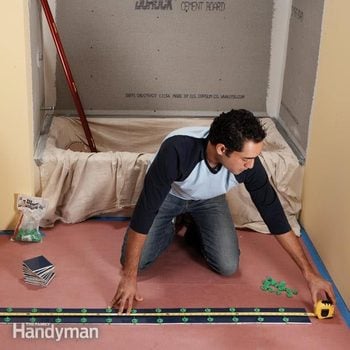Tile Layout for Tubs and Showers
Updated: Mar. 20, 2019Get started with the right layout to achieve the perfect tile job.

Overview
Don’t let a tub and shower tile layout job psych you out. Follow these planning, measuring and installation tips on how to lay out tile.
Video: Create Your Own Floor Tile Layout
Planning the layout for a tile project is usually the hardest and most time-consuming step. Watch this video to learn how a pro does it. You’ll see how to snap chalk lines and make sure they are perfectly square. Plus, you’ll learn how to avoid unsightly narrow, difficult-to-cut tiles along a wall. Don’t start a tile project until you’ve watched this video!
Tile layout preparation
Mock up and measure a row of tile to determine the layout. If you’ll be using spacers to create grout lines, add them between the tiles before you measure. Use the measurement as your tile layout calculator and use it to determine whether you should shift the layout to get a wider tile in the corner, and to determine the tile layout for the end walls of a tub or shower.
Draw level and plumb tile layout lines on the wall to guide your installation. Measure a row of tile to determine the location of the plumb line on the back wall. Subtract about 3/4 in. from the height of the tile and use this measurement to locate the height of the level line above the tub or shower.
No skinny tile strips
Don’t leave a skinny strip of tile in the corners. Plan for the widest possible corner tile for the most attractive tile job.
Locate the starting plumb line to leave the widest possible same-sized tiles at each corner. Lay out the tile on the floor and use the back wall measurement to determine how wide the corner tiles will be. If starting with the edge of a full tile in the center of the back wall leaves a skinny strip in the corner, shift the plumb line by half the width of the tile. This will increase the size of the corner tiles.
Start out level
Screw a straight board to the level line and stack tile on the board. When you’ve completed tiling above the board and the tiles are held firmly, remove the board and cut the first row of tile to fit. Leave a 1/8-in. space between the tub and the tile to allow installation of a flexible bead of caulk. This tip also allows you to wrap tile around tub corners as shown in the photo below.
Don’t start the first row of tile by resting it against the tub or shower. It’ll cause trouble because most tubs and showers aren’t perfectly straight or level. Your tile will wander from the plumb line, and misaligned grout lines will be your only solution.
Tile extends beyond tub
Plan the tile layout so a column of tile extends past the end of the tub. Use the method shown in the “Mock up and measure” photo above to determine how wide the corner tile needs to be in order to extend the tile beyond the tub. Plan to extend the tile 2 or 3 in. beyond the tub and to leave at least a half tile along the wall if possible.
Don’t stop tile even with the end of the tub. This leaves the walls along the front of the tub vulnerable to water damage, and doesn’t look as finished as tile extending to the floor. Get more tips on how to lay out tile here.
Required Tools for this Project
Have the necessary tools for this DIY project lined up before you start—you’ll save time and frustration.
- Level
- Line level
- Tape measure
Required Materials for this Project
Avoid last-minute shopping trips by having all your materials ready ahead of time. Here’s a list.
- Tile (regular and wider)
- Tile spacers












